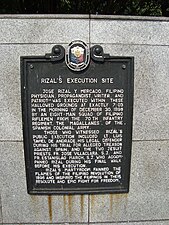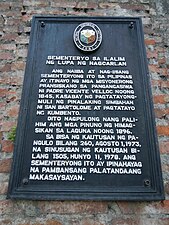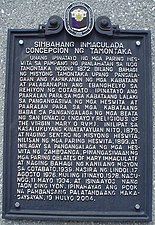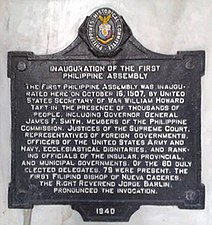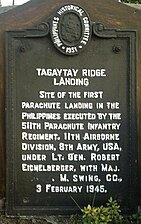National Historical Commission of the Philippines
T.M. Kalaw Avenue, Ermita, Manila | |
| Location | |
|---|---|
Chairperson | Lisa Guerrero Nakpil |
Executive Director | Carminda R. Arevalo |
| Website | nhcp |

The National Historical Commission of the Philippines (
History
The present day NHCP was established in 1972 as part of the reorganization of government after President
Philippine Historical Research and Markers Committee (1933)
The Philippine Historical Research and Markers Committee was created by
This first committee was composed of American journalist Walter Robb who served as chair; American Anthropologist H. Otley Beyer who would later be known as the father of Philippine Anthropology; Spanish Jesuit Fr. Miguel Selga, SJ; dean Edward Hyde from the University of the Philippines College of Engineering; and Filipinos Jaime C. de Veyra, Conrado Benitez, and Eulogio Balan Rodriguez.
Philippines Historical Committee (1935)
With the establishment of the
In the postwar reconstruction years the PHC was busy as there was a government interest in "the reconstruction of the past as a means to form nationhood." Reconstituted six months after Philippine independence in 1946, the committee was first placed under the Office of the President, and then transferred to the Department of Education. During this time, it installed over 400 historical markers all over the archipelago; named and renamed various streets, plazas, towns and other public places; and acquired places and relics of heroes.
As the nation rebuilt itself, a number of other historical commissions were also created by law to commemorate the birth centennials of various Philippine heroes of the late 19th century. All of these commissions were eventually merged into one National Heroes Commission created in 1963.
National Historical Commission (1965)
In July 1965, Congress passed Republic Act No. 4368 that created the National Historical Commission (NHC) and effectively abolished the Philippine Historical Committee and the National Heroes Commission whose functions were delegated to the NHC. Among the functions of the NHC are the following: to publish or cause to have written or published the works of our national heroes and other great and good Filipinos; to compile from various sources here and abroad data on Philippine history and prepare and publish there from source books on Philippine history; to identify, designate and approximately mark historic places in the Philippines and to cause the construction or reconstruction and to maintain and care for national monuments, shrines and historic markers that have been erected; to take charge of all historical activities or projects not otherwise undertaken by any entity of the government; to gather data on historical dates, personages, events, and documents presented for evaluation, and to acquire through purchase, donation, exchange or otherwise, important historical documents and materials; and to encourage researches in Philippine history and the writing and publication of textbooks on the subject, the research and writing of biographies of heroes, accounts of historical events, translations of important scholarly works of Filipinos and foreigners by providing appropriate or adequate incentives.[5]
National Historical Institute (1972)
In 1972, President Ferdinand Marcos' declaration of martial law resulted in a reorganization of government and the renaming of the NHC as the National Historical Institute.
National Historical Commission of the Philippines (2010)
On May 12, 2010, President Gloria Macapagal-Arroyo signed Republic Act No. 10086, or the law reverting the National Historical Institute into its original form as the National Historical Commission of the Philippines.[6]
Current Activities
The NHCP still undertakes all the functions of the previous commissions, most notably those of preserving historical sites and structures and serving as lead agency for the commemorations of Independence Day and Rizal Day.
- Historical markers issued by the NHCP and its predecessors
List of Chairpersons

- Walter J. Robb (October 23, 1933 – January 19, 1947)
- Eulogio Balan Rodriguez (January 20, 1947 – April 3,1949)
- Encarnacion Alzona (September 1966 – July 1967)[7]
- Carmen Guerrero Nakpil (July 1967 – 1971)
- Esteban A. de Ocampo (1971 – January 1981)
- Serafin D. Quiazon (January 1981[8] – 1997)
- Samuel K. Tan (1997–1999)
- Pablo S. Trillana III (1999 – April 2002)
- Ambeth R. Ocampo (April 2002 – April 7, 2011)
- Maria Serena I. Diokno (April 7, 2011 – November 29, 2016)
- Rene R. Escalante (November 29, 2016 – March 1, 2023)
- Emmanuel Franco Calairo (March 1, 2023 – March 26, 2024)
- Lisa Guerrero - Nakpil (March 26, 2024 - present)
List of Executive Directors
- Danilo S. Manalang (1997 – December 2002)
- Ludovico D. Badoy (December 2002 – February 2020)
- Restituto L. Aguilar (February 2020 – February 22, 2021)
- Carminda R. Arevalo (February 22, 2021 – present)[A]
- A Served as Officer in Charge of the Office of the Executive Director of the NHCP from February 22, 2021 to November 11, 2023.
See also
- List of historical markers of the Philippines
- Philippine Historical Association
Further reading
- Rakkan, S. (2018). Prawattisāt niphon Filippin kap chatā kam khō̜ng chāt [Philippine Historiography and the Searching for the Destiny of the Nation]. Bangkok: Illuminations Editions. (in Thai) ISBN 9786169313878
References
- ^ "Mission". National Historical Commission of the Philippines. Retrieved September 17, 2016.
- ^ Ocampo, Ambeth (November 11, 2008), "Looking Back: A personal introduction", Philippine Daily Inquirer, archived from the original on February 28, 2009
- ^ a b Salazar, Dionisio S. (October 1979). "A Brief History of the National Historical Commission" (PDF). The Annals of Philippine Chinese Historical Association (9th): 57–63. Archived from the original (PDF) on November 21, 2023. Retrieved November 21, 2023.
- Official Gazette of the Republic of the Philippines. January 23, 1937. Retrieved November 21, 2023.
- ^ "Republic Act No. 4368". Supreme Court E-Library. Supreme Court of the Philippines. June 19, 1965. Archived from the original on September 2, 2022. Retrieved November 21, 2023.
- Official Gazette of the Republic of the Philippines. May 12, 2010. Retrieved November 21, 2023.
- ^ National Historical Commission (1975). Lectures on Great Filipinos and Others, 1967–1970 (Second ed.). Manila: National Historical Institute. p. 6. Retrieved July 10, 2019.
- ISBN 9715380115. Retrieved July 10, 2019.

